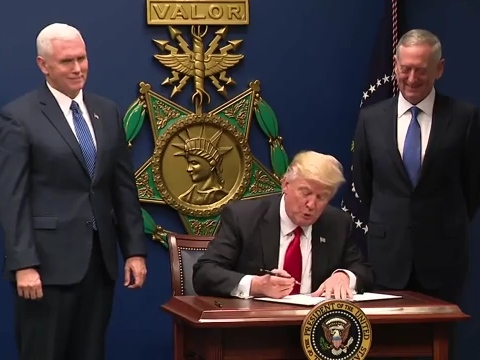- Unburdening Obamacare: On January 20, 2017—the same day Donald Trump was inaugurated as the 45th President of the United States—President Trump enacted his first executive order to diminish the economic burden of the Affordable Care Act (ACA) so that states gain the flexibility and control necessary to operate a freer and more open health care market than Obamacare provides. This allows the Secretary of Health and Human Services to cooperate with the heads of other agencies and departments empowered by the original ACA to delay, defer, waive, or grant exemptions from any provisions or requirements the ACA imposes that create financial burdens for the state.
- Withdrawing from TPP: On January 23, 2017, President Trump formally withdrew the United States from the Trans-Pacific Partnership that President Obama organized and signed with eleven eastern countries such as Japan, Taiwan, and Singapore. This allows Donald Trump to replace the original trade deal with individual trade deals with each of the eleven nations, which he can terminate within thirty days if he sees fit. This is the fulfillment of a campaign promise President Trump made multiple times during election season.
- Mexico City Policy: Also on January 23, 2017, President Trump reinstated the Mexico City Policy, which President Reagan initially enacted in 1984. It requires nongovernmental organizations (NGOs) to refrain from performing or supporting abortion as a means for family planning in other countries. To enforce this policy, any of these NGOs that violate the policy by performing or supporting abortion lose federal funding for their operations. President Clinton rescinded the policy in 1993, and President George W. Bush reinstated it. President Obama, then, rescinded it yet again in 2009, requiring President Trump to reinstate it once more.
- Keystone XL and Dakota Access Pipelines: On January 24, 2017, President Trump reinitiated the Dakota Access and Keystone XL oil pipeline construction projects. The Obama Administration stopped these projects from progressing. Donald Trump not only signed executive actions to advance the approval of these construction projects but also declared in the process that the pipelines be built with American materials, which also accelerates the regulatory process for construction and shortens time spent in the preliminary, environmental review.
- Mexico Border Wall: On January 25, 2017, President Trump signed two correlating executive orders to direct the construction of the wall he promised during his campaign. Along the U.S.-Mexico border, he ordered the wall to be built and also ordered the boosting of border patrol forces. His order also increases the number of immigration enforcers who handle deportations, and it includes an order to pull federal grants from sanctuary cities, specifically those grants used to harbor immigrants. This potentially allows authorities to prioritize more undocumented immigrants.
- Immigration Reform Order: On January 27, 2017, President Trump took executive action to suspend the admittance of refugees for 120 days. The same order denies entry to citizens of seven specific countries for 90 days; the specified countries—all of which are designated Muslim-majority nations—are Syria, Yemen, Sudan, Somalia, Libya, Iran, and Iraq. Trump’s immigration order led to border security detaining a large number of foreign nationals at several major airports, which has sparked controversy. The Trump Administration has since amended the order to exempt visitors who carry green cards from being detained, as the order originally suspended their access as well. Federal judges are also impinging upon the scope of Trump’s immigration reform by issuing rulings that stop certain visitors from being deported.






